| Article ID | Journal | Published Year | Pages | File Type |
|---|---|---|---|---|
| 760381 | Energy Conversion and Management | 2016 | 9 Pages |
•Swirl ratio and uniformity index was assessed for six different engine designs.•Lower bowl-depth and higher bowl radius create higher squish and swirl.•The best design for power boost and emission control strategies were identified.•The flow dynamics are considered based on TKE and also the flow field vectors.
Geometrical features of combustion chamber are important factors in subsequent engine’s combustion and emissions. Location and configuration of bowl in diesel engine has been the dynamic field of research especially for optimization procedure. This study considers six different engine patterns with outlined parameters. It follows that different designs are characterized with different swirl motions and tumble flows within the combustion chamber. It was determined that maximum and minimum peak swirl number pertains to “Design5” and “Design1” with 1.59 and 1.1 values, respectively. By using “Design5” case instead of “Design1” (baseline case), uniformity index increased by 25.83% whereby peak soot concentration was reduced over 46.7%. The bigger bowl radius (R1) makes higher swirl ratio and this eventually leads to lower soot emission. Lower bowl depth (T), however, gives way to stronger squish pressure and engine-out power.
